It’s Monday morning and you’re driving to work. It snowed last night, and the roads are icy. You’re in a rush to get to work in bumper to bumper traffic on Deerfoot. The brake lights flash on the car in front of you, causing you to slam on the brake pedal. There isn’t enough time for the car behind you to break and they slide into the rear end of your vehicle. A rear-end impact leads to forward acceleration of your trunk and shoulders. Your head moves backwards, forcing your neck into extension. Following this extension, your head accelerates forward, forcing your neck into flexion. Classic whiplash. The rapid flexion and extension of your neck can damage the spine joints, muscles, ligaments, nerve, cartilage or bone. This damage may potentially lead to impairments in physical and mental functioning and difficulties with participation in activities of daily living. Stress may also aggravate your symptoms and delay recovery.

Whiplash Treatment
What is whiplash?
To summarize, whiplash is a neck injury due to forceful, rapid back and forth movement of the neck. Most commonly, it is caused by rear-end car accidents. It can also result from sports accidents, physical abuse and other types of trauma, such as a fall.
Signs and symptoms of Whiplash
Whiplash signs and symptoms may vary depending on the specific mechanism of injury. They may present immediately after the accident or they may take hours or days to show up. Common symptoms include a sharp or dull pain in your neck that may radiate into your shoulder or arm region. This pain tends to be worse when you move your neck. Overall, the neck feels stiff and the range of motion is decreased. The neck muscles may also have increased tone and be tender to touch. You may have a headache that starts at the base of your skull and radiates forward. Possible neurological symptoms, such as numbness and tingling, may also be present. Lastly, deafness, dizziness, ringing in your ears, memory loss, problems swallowing, and jaw pain may also be present.
Treatment for whiplash
A qualified physiotherapist will be able to assess your specific concerns and create an individualized treatment plan. Initially, treatment will center on restoring normal neck mobility and strength and decreasing pain. This will be accomplished through the use of manual therapy and therapeutic exercise. Manual therapy will include massage, soft tissue release, joint mobilization of the neck and upper spine and acupuncture. Therapeutic exercise will be based around helping you return to your normal daily life activities by reducing pain and gradually increasing activity level. Calgary’s Panther Sport Medicine and Rehabilitation Centers have qualified physiotherapists who will be able to guide you through managing this condition. Visit one of Calgary’s nine Panther clinics today to get started on your personalized road to recovery.





